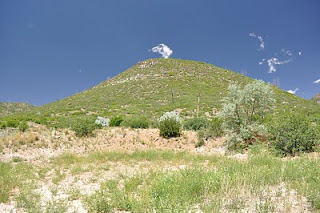I love my new camera. It can do everything. And with the help of the few accessories I've gotten for it so far, it can do even more.
One of the accessories I've bought is a circular polarizing filter. One of the things that the filter can do is darken the sky without changing colors since the sky far from the sun is polarized a bit.
The first part of my picture project was to see the polarized filter in action.
First, here is a picture looking west at Burnt Mountain. This picture has the polarizing filter oriented so that it aligned with the sky's polarization. It doesn't darken the sky.
Now I have rotated the filter 90˚. The sky has darkened and the clouds became more apparent. You can better see the quarter moon just to the left of the mountain (about half way up the mountain).
I didn't do any tweaking of the colors so the greenery has gotten lighter in the second picture since the automatic exposure has compensated for the darker part of the picture.
Another thing that the camera can do is take very long exposures. Here is the same shot (well, zoomed in a little...I didn't really mean to do that) later that day. This was about 10:30 that night and the exposure lasted 107 seconds, not quite two minutes.
If I had had the zoom set the same for the two pictures we should have been able to compare the lengths of the stars' trails to the diameter of the moon in the previous picture. It takes about two minutes for the moon (or the sun) to move its width across the sky. So the stars' trails should be about the same width as the moon. At least for the stars near the equator.
I repeated this exercise with the mountain to the north. First, with minimal darkening from the polarized filter.
And maximizing the sky's darkening.
And a 206-second exposure that night.
Though there is nothing to contrast this picture with, here is a 13-minute exposure of Polaris and its surrounding stars.
To the left of Polaris is a short track of a meteor or a satellite flare. Along the bottom of the picture you can see the dotted line of an airplane's navigation lights as it flew across the shot. And from around the middle of the bottom to the middle of the right side there is a solid line, either a satellite or a meteor (or maybe it's a flying saucer!).
Now I have to make myself a barn door tracker and try to shoot the sky without the stars leaving trails. But then, I don't make it to places with dark skies very often. When you live in the big city, you give up a lot of your stargazing.











